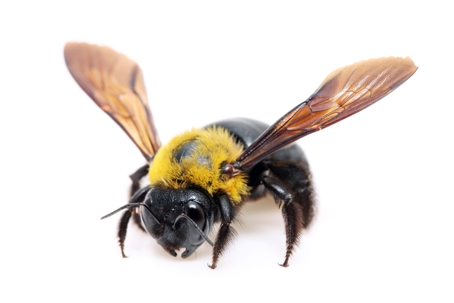Carpenter Bees 101
What Are They?
Carpenter bees are a non-aggressive pollinating species, known in the Spring and Summer to bore holes into wooden homes and other structures. They do so to create a place for their eggs, but they do not consume the wood. They eat nectar and pollen like other bees.
Called carpenter bees for their tendency to burrow into wood, most out of the hundreds of carpenter bee species live in the bark of trees. Many use plant stems and bamboo to make their nests. They also live in the framework of buildings, and may even take small fragments from bricks and cables as well. They are solitary, not working as a colony like other bee species.
Where Do They Live?
The University of Maryland explains why : carpenter bees are focusing mainly on breeding. So it is a big deal for female carpenter bees specifically to successfully build their nests. They dig a couple of inches deep into the wood, just big enough to fit their bodies twice over. They then dig a few more inches deeper over time to “follow the grain of the wood.”
Nectar and pollen and a single egg are then systematically stored in individual cells in the tunnel. Over generations of bees, the hole will elongate for reuse. Male carpenter bees fertilize female bees and protect the nests during their construction. They use intimidation on humans and other flying animals that stray too close by buzzing around their heads to scare them off.
Do They Sting?
Carpenter bees are capable of stinging, but only the females, which only sting when provoked. Their stinger is not hooked or barbed but can sting more than once, unlike killer and bumblebees who only sting once. Luckily, many people are likely to come in contact with male bees, who do not even possess a stinger.
The bees you encounter outside your home may be due to carpenter bees nesting nearby but can also be hard to distinguish from other kinds. Naturally, many homeowners are prone to panic, but it is important to remain calm and try and identify possible infestation from a safe distance.
How Do You Identify Carpenter Bees?
Pest World identifies carpenter bees as typically having yellow or black abdomens with six legs and short antennae. They can be up to an inch in length and are common throughout the US. Their furry upper bodies are distinct from bumblebees, who are known for their yellow-and-black-striped abdomens.
Pestworld informs that you can find them nesting in small holes in the wood of your decks. This includes roofing, porch railings, and other wooden constructions. The most noticeable signs of a carpenter bee infestation are the yellow-black stains around the area and heavy bee activity around the nest; male bees are protective of the females.
Other signs of an infestation include stains of bee excrement around holes, sawdust, and wood pulp where no construction has recently occurred.
Is it Safe to Handle a Carpenter Bee Infestation?
Carpenter bees may cause structural damage over time if left untreated. If you see these signs around your property, it is not advised to engage them. Penn State articles point out that quick movement and noticeably agitated behavior riles them up. While virtually harmless, this form of defense makes them a misunderstood species often mistaken for similar, more aggressive bees.
Seeking professional help may be wise, as you can’t be sure how many are nesting in your property. Especially when late Summer arrives and female and male carpenter bees have finished the reproduction cycle, the newly adult bees will emerge from their cells after months to repeat the reproduction process.
For severe infestations, hiring a pest control company to quickly identify and manage the situation.
Reach out to the local pest control experts at Pest Assassins today!
At Pest Assassins, we are a local family and veteran owned company offering stinging insect control in Massachusetts and Rhode Island. Contact us today for a free quote for wasp and carpenter bee control.

